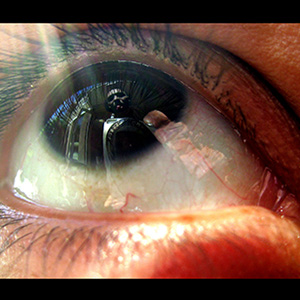Immersion
How Patterns Create Engagement
In game design circles, one of the most over-used (yet ironically, one of the least understood) words you will hear is immersion. For the most part, when people use this word they intend for it to mean one of two things. Either they mean 1) “a fascination or intense mental effort that absorbs the complete attention of the game player”, or 2) “a game environment that is so believable that it psychologically and emotionally draws the user into the fictional world.”
A more detailed description of the immersive state can be found in Mihály Csíkszentmihályi’s work on Flow. According to Csíkszentmihályi’s theories, Flow is a state of concentration or complete absorption with the activity at hand. To achieve this state, a balance must be struck between the challenge of the task and the skill of the performer.
In the second definition, the focus is clearly on the fiction. We use the word fiction with a loose definition, not limited to a linear, plot driven story arc, but rather encompassing the general fictional environment and atmosphere. In this case, the world is a logical, consistent, believable place. The player can picture themselves in it, and in extreme cases even partially believe it is real (in an imaginative sense, i.e. it feels like it at least should be real). Both definitions are similar, yet they contain key differences. In the first one, the focus is probably on the mechanical aspect of the game play. A player could be said to be immersed in a game like Tetris. In such a game, as the difficulty level increases the player must focus more and more of their attention on performance. When their attention becomes fixated to the exclusion of any external influence, they are said to be immersed in the game.
While it is useful to understand the definition of immersion, the goal of the game designer is to endeavor to produce the result. How can we immerse a player in a game? The key, as we shall see, lies in the common concept between the two definitions. Both forms of immersion serve to spark mental activity. They engage the brain. Whether we are capturing a player’s imagination or causing them to think and process intently, in either case, we are causing the brain’s cognitive processing to go into overdrive.
Patterns – The Engine of Engagement
The question, then, becomes one of discovering how to spark that mental activity. In order to answer this question, let’s digress momentarily to the earliest stages of formative development. Consider a newborn infant. With very little information stored in their brains, infants perform almost no activities other than eating, sleeping, and crying.
However, at some point, the child’s mother begins repeatedly putting her face in front of the child’s eyes and saying the word “mama” over and over. Eventually, the child establishes an associative connection between the sound and the image, repeats the sound, and is delighted by the excited cooing of the mother.
Over time, the child is exposed to a barrage of images and sounds (words), and learns to associate each particular image with its corresponding sound, and mimic that sound. In other words, the child learns to speak.
This is all very straightforward, and we’ve all heard it and seen it for ourselves many times. However, a critical question is: why does the infant choose to associate the image of mama’s face with the sound of the word “mama”? Initially, it can’t be for the positive reinforcement, because before they ever form the word, infants haven’t yet experienced a “reward” per se. So what is it that very first time that causes an infant to want to recognize a specific face, and then connect it to a specific sound?
The most obvious answer is: That’s what the human brain is hard-wired to do. The basic, hard-coded functionality of the human brain (aside from autonomic and sensory input processes) is to recognize patterns (sounds, images, scents, feelings, concepts, etc), store them, and connect them to other patterns. The processing part of the brain is basically an organic machine that is designed to perform this one specific cycle over and over. It’s what we’re built to do.
Examples of The OSV Cycle
If we can accept that initial premise, it is then possible to use it in a functional sense. The idea is that in order to engage the brain of the player (or reader), to immerse them, we should seek to establish a repeated cycle of exposing them to patterns, providing them with the ability to connect those patterns, and then providing a reward for correct results. In short, the entertainment should allow the audience to Observe, Speculate, and receive Validation as often and in as many ways as possible. We will refer to this cycle as the OSV Cycle.
As it turns out, this very simple cycle can be employed in a wide variety of ways. A simple example can be found with Fighting Games. You may not even be consciously aware of it, but when you push the appropriate buttons to execute a specific move, your fighter gives a ‘cue’ to the opponent that indicates what he is about to do. Maybe he shouts a specific battle cry word, or performs a kind of ‘wind up’ animation. Maybe his eyes flash for a moment. Maybe his weapon crackles with energy. There’s always some indicator, and it is a different indicator for each kind of attack. This same behavior is also demonstrated in fiction and movies. The characters engage in patterns, and we are trained as an audience to recognize those patterns, and use them to anticipate the character’s actions.
The result in fighting games, of course, is that the experienced opponent is tipped off about what’s about to happen. If the opponent recognizes the move quickly enough and executes the appropriate counter-move, he or she blocks or avoids the attack. If the counter is executed is too slowly, the player’s character gets whacked. The OSV cycle has been fulfilled at that point. The opponent Observed the tip-off cue, processed it and Speculated the appropriate counter-move, and then received Validation (they didn’t take damage) if they were correct.
This simple version of the cycle takes place over and over many times in a standard fighting game. However, other, more complex patterns will also begin to emerge. As a player continues the fight, they may notice trends in their opponent’s behavior. Maybe they see something like a continuous repetition of high attack, high attack, and power move. If the power moves are slower, it is probably possible to execute high block, high block and then a fast attack, spoiling the power move. Again, the OSV cycle will have been fulfilled.
It is useful to point out here that the main reason that so many games focus on fighting, shooting, etc, is because the generally tends to reduce the OSV cycle to one of instant feedback. Players tend to get impatient if the effects of their actions trail too far behind the underlying causes. It is possible to have some longer term OSV cycles, but it’s usually more successful in videogames if the majority of your OSV patterns contain fairly quick validation.
The OSV cycle can also be fulfilled in more aesthetic ways. Have you ever watched a horror film, like, say, something in the Friday the 13th series? You watch one of the victims sneaking off to investigate a sound in the basement, and that chh-chh-chh music/sound starts playing. Since that sound plays every time someone is about to get killed, we’re expecting Jason is down there somewhere. Again, we have the OSV cycle. We hear (Observe) the same sound in similar situations, it allows us to assume (Speculate) what’s about to happen, and then we see (receive Validation) the spurt of blood as another idiot victim bites the dust.
We find another very different example of the OSV Cycle in the television series Star Trek The Next Generation. Consider how the makers of this program designed the sets for the different races. On board the bridge of the Enterprise, we find an architecture that is very bright, open, high tech, and squeaky clean. It is no accident that we could use these same adjectives to describe the way Federation officers are portrayed.
Conversely, on board a Klingon bridge, the space is cramped and intrusive. The architecture is bulky, strong, and almost primitive, while the red lighting colors everything with an oppressive, almost feral quality. Again, these are adjectives that are appropriate to the very strong character type that the writers have created for Klingons.
And if we were to search for a third example from the show, we could look inside a Borg ship. Here we find a vast, endless space that is filled with interconnecting pipes and conduits. It is almost as if every part of the ship is connected to every other part. It feels somewhat like a high tech beehive. As we all know, this is an apt description for the Borg themselves. The Borg are a race of totally interconnected machine-beings that demonstrate behavioral qualities not unlike a colony of bees. (Oh, and for the record, I am friends with one of the original staff writers for STNG, and he verified for me that this was indeed the intentional model that they used for the Borg.)
These examples show us a subtle, but no less important sort of use for the OSV cycle. The viewer can Observe the properties of the environment, draw conclusions (Speculate) about the nature of the beings that live and operate there, and of course receive validation when the expected behaviors are indeed demonstrated.
In some ways, this is reminiscent of modern detective shows, where some criminal profiling detective stumbles into the lair of the bad guy, examines the surroundings, and draws conclusions about said bad guy’s personality. It’s a subtle but very powerful use of the OSV concept that works almost unconsciously on the viewers, even when there isn’t a detective to draw the conclusions for us.
Music is a type of OSV concept that is used extensively in film. You’ll find that tempo, style, and even the choice of instruments in a given musical composition can suggest time periods, emotional content, activity, tension, ethnicity, and many, many other concepts. Film makers sometimes even use music to create a kind of ‘filter’ for the scene, subtly changing the meaning of the action. For instance, a typical car chase scene might be backed by a high energy, industrial track, simply reflecting the action on the screen. Then again, the same scene might utilize a piece of classical music, which transforms the car chase into something like a graceful ballet, accentuating the skill of the drivers. Or perhaps the music will be a wacky, cartoonish piece, creating a more humorous scene. As long as the resultant combination reinforces the actual intent of the scene (action, skill, comedy, etc) then it still fulfills the OSV promise.
The brain is constantly observing, associating, speculating, and testing. We are built to look for patterns and then use those patterns as a predictive tool to enable us to draw conclusions about related things in the same psychological vicinity. We do this with every kind of informational input. It doesn’t matter whether we are looking for visual patterns, auditory, tactile, scent, taste, behavior, patterns of speech, music, or really anything else. We constantly absorb this sort of information, process it, and try to form connections with the other patterns around it. It’s also important to consider the ‘correctness’ of the environment. Picture the Klingons living aboard the Enterprise. With their semi barbaric, violent, dictatorial, intrusive personalities, they would look awkwardly out-of-place aboard a Federation ship. If a viewer were to be presented with this environment as their initial introduction to the Klingons, it would feel inconsistent. The viewer’s brain would draw conclusions about the personalities of the Klingons based on their living space, but these conclusions would be wrong when compared to Klingon’s actual behavior. And since the environment and the characters would both be constantly present, this nagging inconsistency would tug at the viewer’s subconscious as a constant contradiction. It would just feel wrong. (Worf is an interesting exception. While he is definitely a fish-out-of-water, he is nonetheless able to fit into the bridge team. he character works because he is different, but that’s a bit of an advanced concept.)
As game developers we need to be aware of this. Constant awareness that the viewer’s brain will be operating on all kinds of levels to try to associate things will help us to design more consistent games, environments, and stories. When everything is consistent, when it makes sense, it immerses our brains in a continuous cycle of pattern recognition and processing. And since this is essentially what we are built to do, we tend to respond positively to it.
Things to remember
- A functional definition of immersion is: anything that engages the attention of the brain to a high degree.
- The critical idea behind engagement is the notion that the human brain is, essentially, hard-wired to recognize, store, and combine patterns. This fixation with patterns is a fundamental human trait.
- OSV concepts can be used not only in character design, but also in environment design, sound, music, dialogue, animations, and virtually any other observable aspect
- Contradictory sets of observations (such as in our example above with the Klingon stereotypical behavior aboard a Federation ship), affect the viewer negatively. Each set of observations causes the viewer to draw conclusions that contradict the other set of observations. It winds up feeling
Note that often the reward for a correct Speculation on the part of the viewer is simply the Validation they experience when the character acts the way they guessed he would, or the appropriate action takes place in response to fictional events, or when the high tech gizmo operates the way it looks like it should operate.










